Symptom 7: Bleeding and Crusting: The Traumatic Outcomes of Neurodermatitis

As we venture further into the realm of neurodermatitis symptoms, we encounter a more distressing side of the condition: bleeding and crusting. Coming on the heels of the persistent itch, skin transformation, raised rough patches, skin redness, dry, scaly skin, and hair loss, the physical trauma resulting from neurodermatitis becomes evident.
The incessant scratching that defines neurodermatitis doesn’t go without leaving a mark. The skin, under the relentless assault of scratching, often surrenders to this physical trauma, resulting in bleeding. It’s a telltale sign that the skin has been pushed beyond its limits.
Following the bleeding, the skin rallies its recovery troops. It responds by forming a crust over the wounded area – a natural part of the skin’s healing process. This crusting, while a protective response, also contributes to the rough and irregular texture characteristic of skin affected by neurodermatitis.
But the cycle doesn’t end there. The crusts, in their quest to protect the wound, can heighten the itch sensation. This intensified itch tempts scratching, which can lead to the crusts being scraped off, causing more bleeding and setting up the stage for fresh crust formation. It’s a vicious cycle that perpetuates the traumatic outcomes of neurodermatitis.(7)